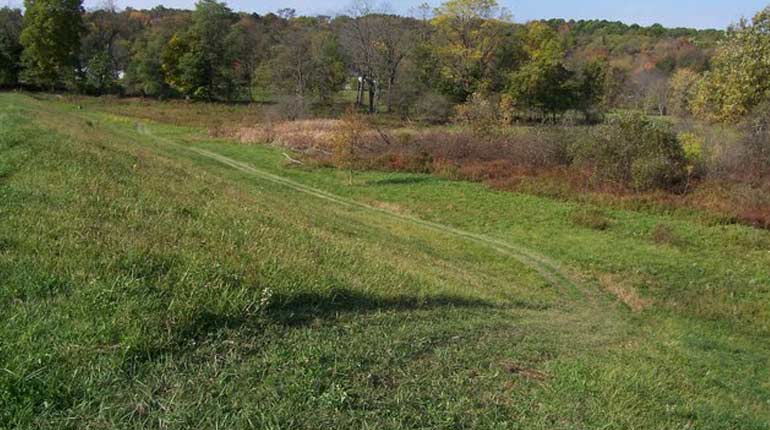

At Work | 2006
Summary of maintenance and special projects completed in 2006.


Summary of maintenance and special projects completed in 2006.


Structure 37L-1 included a 21-inch diameter drop inlet and a 12-inch vertical berm drain on 148 ft. of pipe. The drop inlet had rusted out causing the soils to be washed out around the pipe resulting in continued erosion and a safety hazard. In addition, the 148 ft. pipe was rusted out along the bottom. The photo shows sections of the old pipe choked full of dirt and debris.


Damage to earthen embankments by off-road vehicles is a dam safety concern for Subdistrict staff.


An access road at VIII-D had significant erosion damage. Additional stone was added along with a diversion swale along the right side of the road to repair the road and protect it from further erosion.


Many sections of channel banks were overgrown with brush and trees and needed to be cleared to create access for equipment used in repairing structures. Part of the left bank downstream from Coal Bank Rd. was cleared and is now mown yearly to maintain it.


The Ohio Department of Natural Resources Dam Safety regulations require flood control dams to be mown at least once per year and preferably twice a year. Four of the dams currently are mown twice a year, the other four are mown by the land owners anywhere from one to three times a year.
Since the beginning of the Chippewa Flood Control System, and during the past twenty-five years, much of the needed maintenance could not be completed as planned due to lack of funding. This caused many of the channel banks to become overgrown with woody vegetation, which made it near to impossible to maintain the banks or the culverts installed for the purpose of draining the floodwaters. In addition, as trees grew, many would lose branches or fall into the channel causing log jams, bank erosion, and more localized areas of flooding due to the inability of the stream flow to get through the blockage.
Maintaining the 33 miles of channel helps to ensure that flood waters will recede from the land, quickly and efficiently.
During the past ten years, an effort by the Chippewa Subdistrict has been made to provide funding through an assessment permitted by the Conservancy District Laws of Ohio.
These assessment dollars, which can only be spent on maintenance of the Chippewa Flood Control Project, have been utilized on several projects designed to return the Project to its original design objectives.
*For activities prior to 2005, contact us.
Maintenance Activities must be done consistently to keep the Flood Control System working properly. Dams and channels must be mowed annually to manage woody growth, and provide access to allow for equipment and inspections. Visit Structure 37L to see a recent example of maintenance.
When the Chippewa channel was constructed, nearly 500 pipe structures were installed. These structures used corrugated metal pipes (CMP), which vary in diameter and length, and are an integral part of the System as they move runoff water safely into the channel. The CMP pipes have exceeded their lifespan and are being systematically replaced with superior quality pipe, such as high density polypropylene (HDPP) or high density polyethylene (HDPE). These new pipes are intended to last for many decades.
Special Projects vary each year and involve items of work that are outside the usual scope of maintenance. They are necessary to keep pace with new standards and regulations, as well as changes in the Watershed.
Our GPS / GIS mapping is a Special Project allowing us to locate and evaluate nearly 700 hydraulic structures originally installed throughout the channels. When completed, Subdistrict staff will be able to prepare a proactive maintenance schedule to ensure that structures are repaired or replaced before failure occurs.